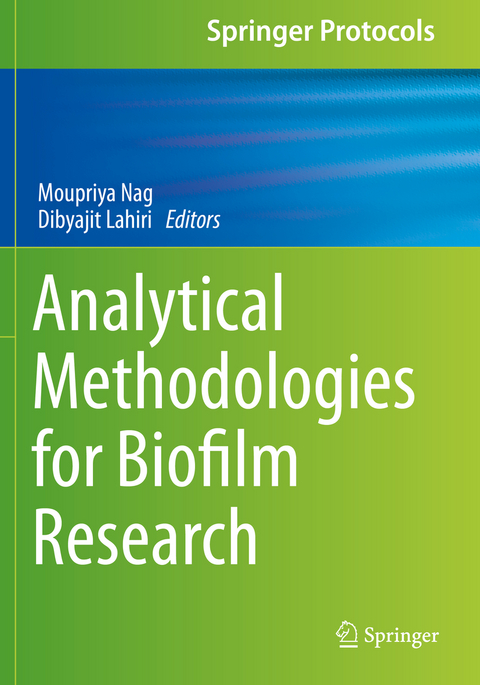
Analytical Methodologies for Biofilm Research
Springer-Verlag New York Inc.
978-1-0716-1380-1 (ISBN)
This book is meant forresearchers in the field of microbiology and interested in understanding microbial pathogenesis, quorum sensing and biofilm formation.
Moupriya Nag is presently working as Assistant Professor in the Department of Biotechnology, University of Engineering & Management, Kolkata. Her research interests includes single molecule Biophysics of protein unfolding/refolding and protein aggregation kinetics and its mechanism of action especially the amyloid proteins in neurodegenerative disorders. Recently, her research focuses on functional amyloids in bacteria and their relation in forming biofilms. Her work deals with developing novel antimicrobial and anti-biofilm compounds from natural sources including plants, microbes and green synthesized nanoparticles.She has about five years of teaching experience in Biophysics, Bioinformatics,Bioprocess and Biotechnology, Enzyme Technology, Computing, Molecular Modeling and Drug Design. She has also published many research articles in the peer-reviewed international journal and authored or co-authored numerous book chapters. She is also amember of many scientific societies like Indian Biophysical Society and Indian Science Congress Association Dibyajit Lahiri is at present is working as Assistant Professor in the Department of Biotechnology, University of Engineering & Management, Kolkata. His research interest is precisely on biofilm isolated from human prosthesis and its inhibition by various novel phyto and nano compounds. He is keen to explore the molecular mechanism behind the removal of biofilm by natural compounds. His research arena also encompasses computational drug development using bioinformatics. His work is regularly being presented and appreciated before a number of experts of National and International repute. He is a life Member of Indian Science Congress Association and Institution of Engineers (India).
Section I: Introduction to Biofilms.- Chapter 1: Biofilm formation and pathogenesis.- Chapter 2: Sample preparation, basic equipments and common laboratory assay protocols for Bacterial Communities and Biofilms.- Section II: Separation methods and Spectroscopic techniques in Biofilm research.- Chapter 3: Analysing microbial biofilm formation at a molecular level: Role of Fourier-Transform Infrared and Raman spectroscopy.- Chapter 4: In vitro metabolite profiling of microbial biofilm: Role of Gas Chromatography and High Performance Liquid Chromatograpy.- Section III: Electroanalytical techniques for evaluation of biofilm research.- Chapter 5: Microbial electrochemical cells and introduction to Electron transport in microbial biofilm.- Chapter 6: Contribution of Cyclic voltammetry and electrochemical impedance spectroscopy in deciphering the electron transport system in biofilm.- Section IV: Calorimetric techniques in biofilm research.- Chapter 7: Measuring metabolism and bio-energetic profiles of biofilm: Isothermal calorimetry, Differential Scanning Calorimetry and future of Chip Calorimetry.- Section V: In Situ Surface Analysis and Imaging techniques in Biofilm research.- Chapter 8: Analysis of biofilm matrix by Multiplex Fluorescence In Situ Hybridization (M-FISH) and Confocal Laser Scanning Microscopy (CLSM) during nosocomial infections.- Chapter 9: Imaging Bacteria and biofilm by Field Emission Scanning Electron Microscopy (FESEM).- Chapter 10: Probing the Surface-Attached in Vitro microbial Biofilms with Atomic Force (AFM) and Scanning probe microscopy (SPM).- Chapter 11: Nuclear Magnetic Resonance (NMR) and Surface Plasmon Resonance (SPR) imaging as an advanced tool for examining biofilm matrix (Structure, Composition, Dynamics).- Section VI: Molecular Biology and recombinant DNA techniques in Biofilm research.- Chapter 12: Genetic Basis of Biofilm formation and spread of nosocomial infections.- Chapter 13: Monitoring cell distribution and apoptosis in sessile forms of microbial biofilm: Flow cytometry -fluorescence activated cell sorting (FCM-FACS).- Chapter 14: Monitoring gene expression in sessile forms of microbial biofilm: Polymerase chain reaction (PCR) and Real Time Polymerase chain reaction (RT-PCR).
| Erscheinungsdatum | 21.07.2022 |
|---|---|
| Reihe/Serie | Springer Protocols Handbooks |
| Zusatzinfo | 32 Illustrations, color; 24 Illustrations, black and white; VII, 343 p. 56 illus., 32 illus. in color. |
| Verlagsort | New York, NY |
| Sprache | englisch |
| Maße | 155 x 235 mm |
| Themenwelt | Naturwissenschaften ► Biologie ► Mikrobiologie / Immunologie |
| ISBN-10 | 1-0716-1380-4 / 1071613804 |
| ISBN-13 | 978-1-0716-1380-1 / 9781071613801 |
| Zustand | Neuware |
| Haben Sie eine Frage zum Produkt? |
aus dem Bereich


